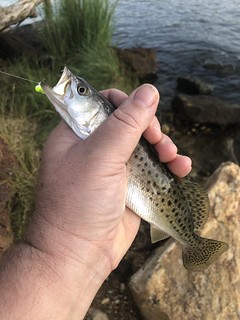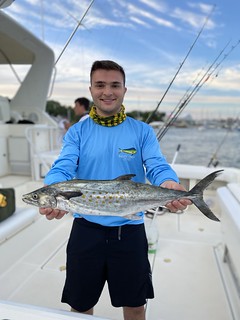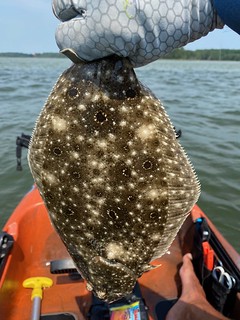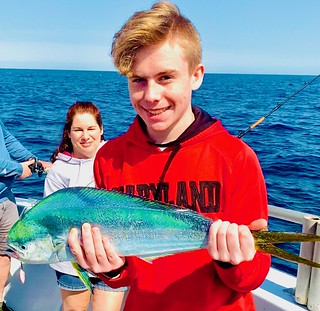Maryland Fishing Report – Sept. 9

Bruce Strickland caught this blue catfish in the Chaptico Bay’s Bankhead Cove. It was 26.25 inches long and weighed about 10 pounds. Photo by Bruce Strickland.
With warm and dry summer weather through the Labor Day weekend, some anglers targeted the bay’s summer species such as Spanish mackerel and red drum, while others have gone back to targeting striped bass. All areas of the Chesapeake Bay and tidal rivers have reopened for striped bass fishing until Dec. 10 with a size limit of 19 inches and a daily bag limit of one fish per angler.
Targeting invasive species such as blue catfish and northern snakehead remains popular.
Expect mild but stable temperatures in the low to mid 80s this week, with a chance of rain through Sunday. Chesapeake Bay surface water temperatures are stable and holding at 80 degrees.
Mild days, moderate winds, and a chance of thunderstorms will keep conditions similar to last week, with Chesapeake Bay gamefish remaining at similar locations on cooler river mouths or main bay structure during the daytime. However, DNR water monitoring is now showing uniform temperatures from the surface down to the Don’t Fish Below this Depth line in most Maryland bay waters. The only exception is from the Bay Bridge down to the mouth of the Choptank River, where deeper waters are cooler than surface waters. This will result in fish that prefer cool water preferring being able to move more vertically to find suitable oxygen and temperature conditions in many areas. This should help improve first light shallow water fishing conditions when surface water temperatures can be several degrees cooler. For information on Maryland’s bay oxygen conditions, see Maryland’s latest hypoxia report for August. As always, best fishing areas could be further refined by intersecting these cool, oxygenated areas with underwater points, hard bottom, drop-offs, and large schools of baitfish.
Expect average flows for Maryland rivers and streams. There will be above average tidal currents on Monday and Tuesday as a result of the upcoming new moon Sept. 17. Expect decreased clarity from algal blooms in the Back, Bush, lower Chester, Choptank, mouth of the Patapsco, and middle Patuxent rivers.
To see the latest water clarity conditions, check Eyes on the Bay Satellite Maps.
For more detailed and up-to-date fishing conditions in your area of the bay, be sure to check out Click Before You Cast. Get regular updates on Maryland’s waters sent to your inbox with our Eyes on the Bay newsletter. Sign up online.

Miles Matsuka, age 6, caught his first striped bass in Furnace Branch Creek, which measured in at 24 inches, on shore with a popper. Photo by Joe Humphries
The Susquehanna River is still experiencing low flows from the Conowingo Dam, which has had limited water releases despite being on an afternoon power generation schedule. Anglers are also fishing at the dam pool for a mix of flathead and channel catfish, along with striped bass. On the Susquehanna Flats, anglers are catching a few schoolie striped bass and some keepers.
The tidal rivers, creeks, and shoal areas of the upper bay are holding populations of white perch. Casting beetle spins, spinners, and small spinnerbaits towards shoreline structure, docks, and riprap should produce perch into early October.
Schools of white perch have been found on shoal areas and humps around Swan Point, the 7-foot knoll, the Bay Bridge pilings, and the Severn and Magothy rivers. Bloodworms and Fishbites on bottom rigs and two-hook Chesapeake Sabiki rigs have been catching them. (As a reminder, no more than two hooks per line are allowed in the Maryland section of the Chesapeake Bay). At the 7-foot knoll, Swan Point, and on the pilings, striped bass are mixing in with the perch. There are also white perch and schoolies around the Key Bridge, which is a popular area for Baltimore anglers. Striped bass will also be found on the upper bay lumps. Some early fall topwater action is starting to develop with striped bass in the shallows during early mornings and evenings.
Blue and channel catfish are still spread throughout the upper bay and the tidal rivers. The Chester River holds the greatest concentration of blue catfish and the area from Chestertown up past Crumpton are great places to fish for them. Some of the blue catfish have weighed up to 30 pounds. Fresh cut baits from gizzard shad or white perch continue to produce action. Clam snouts are also a popular bait for channel catfish.
No large numbers of Spanish mackerel were caught in the upper bay, but small snapper bluefish have moved into the area.

Ethan Zlokovitz, caught this croaker on a yellow Mr. Twister rigged on a ⅛-ounce lead head jig. Photo by Erik Zlokovitz
Spanish mackerel have been a bit harder to find but are still being caught in the middle bay. Most of the action has been around the mouth of Eastern Bay, Poplar Island, and south to the CP Buoy, Chesapeake Beach, and Breezy Point. Anglers have been trolling #1 Drone and Clark spoons in gold behind #1 and #2 planers or heavy inline weights at about 7 knots.

Erik Zlokovitz caught this small but pretty speckled trout along the Chase Creek living shoreline in the Severn River while fishing for white perch. Photo by Erik Zlokovitz
A mix of white perch, croaker, small striped bass, snapper bluefish, puppy red drum, and spotted sea trout are entertaining light-tackle anglers fishing spinners and small jigs in the Severn and South rivers.
During September, the breaking fish in the region are generally made up of Spanish mackerel, bluefish, and small striped bass chasing bay anchovies. Casting across the breaking fish, allowing your metal jig to sink, and then speed reeling is the preferred method to catch Spanish mackerel on light tackle. Good topwater action was recently found around Poplar Island and the mouth of Eastern Bay on mixed species of breaking fish, including striped bass.
Speckled trout in the shallower shoreline areas have been caught by light-tackle anglers all the way up to the Severn River. Casting soft plastics with spinning tackle or Clousers on a fly rod have been producing fish. Soft plastics in the 4-inch to 5-inch range in pearl and sparkle combinations are popular. Prominent points with good current flow, grass beds, and stump fields are all good places to check out during the morning and evening hours.
Puppy red drum in the 12-inch to 14-inch range are mixing in with white perch from the Patuxent River all the way up to the Severn River. Casting beetle spins, small jigs, and Mr. Twisters with spinning gear or small Clouser flies near shoreline structure will produce puppy drum for the next few weeks until waters cool. Anglers are reminded that there is a slot limit for red drum — the fish must be 18-27 inches long with a daily bag limit of one.
White perch and catfish offer plenty of action in the tidal rivers and off docks along the bay shoreline. White perch will hit grass shrimp and bloodworms. Channel catfish can be caught with fresh cut bait, clam snouts, or chicken livers. Blue catfish are being caught in the Nanticoke River above Sharptown and in the Choptank River above the Dover Bridge. Blue catfish prefer fresh cut bait, gizzard shad, or white perch chunks.
An uptick in striped bass action has been reported with the cooling water temperatures. Breaking striped bass have been reported in about 15 feet of water in the mouth of the Patuxent River from the mouth of Town Creek to West Basin. Mackerel and striped bass were found by light-tackle kayak anglers in the lower Patuxent along with white perch, small blues, and cutlassfish.
Spanish mackerel, bluefish, speckled trout, red drum, white perch, and spot have all been providing good action in the lower bay during the past few weeks. If you are searching for mackerel, troll the edges of the shipping channel from the Virginia line north to the middle bay, the shipping channel edge from Buoy 72 south to Buoy 68, and the area from Point Lookout to Cove Point. The standard method is trolling #1 and #2 Drone and Clark spoons in gold behind #1 or #2 planers or heavy inline weights at about 7 knots. Some of the mackerel have been large, in the 25-26 inch range.
Anglers are encountering breaking fish along the edges of the shipping channel; these fish are mostly a mix of Spanish mackerel and bluefish feeding on bay anchovies. Small striped bass can also be mixed in at times. Anglers are also finding large red drum deep underneath the surface activity, and jigging with large soft plastics or spoons will produce catch-and-release action with these large fish until we get some major cold fronts and cooling water temperatures.
Bottom fishing for a mix of spot, white perch, and a few speckled trout has been excellent in the lower Patuxent River. The Cornfield Harbor area, Tangier Sound, and lower Hoopers Island are all great places to get in on the action. Pieces of bloodworm are the most popular bait but peeler crab can also work well. Flounder are being found on the shoal edges near channels in the Tangier and Pocomoke sounds. Gulp baits and live minnows are popular baits, and kayak anglers can get in on the flounder fishery.
Speckled trout are spread throughout the region with much of the best action found on the eastern side of the bay. Casting soft plastics in pearl and sparkle flash near prominent points, marsh edges, and creek mouths is producing good catches. Drifting peeler crab baits near structure and creek mouths will also catch speckled trout and small red drum.
Cobia fishing within the region has been slowing down with a few reported from south of the Target Ship on trolled hoses (surgical tube lures). The best catches of cobia are coming from Virginia waters closer to the mouth of the bay.
Blue catfish in the tidal Potomac River or the Nanticoke River offer good fishing for those wishing to anchor up or bottom fish from shore. The blue catfish are plentiful and offer good eating. Any kind of fresh oily cut bait works well, with gizzard shad and menhaden being common choices.
Recreational crabbers are enjoying some of the best crabs of the season and this will hopefully get better if salinities remain high. The crabs have ventured up the tidal rivers and as far north as the Sassafras River. Crabbers in the upper bay are reporting catches of a half-bushel to one bushel per outing. In the middle and lower bay, catches of a bushel per outing are common. Razor clams remain the bait of choice whether trotlining or crabbing with collapsible traps. Some of the best crab catches are coming from deep water in the tidal rivers. Catches of large crabs tend to pick up in early October in the rivers as far north as the Severn.

Angler Andrew Baum caught this 23-inch largemouth bass in Wildewood Community Pond. Photo courtesy of Andrew Baum.

Angler Joseph Bauer caught this 30.5-inch northern snakehead at Blackwater National Refuge. Photo courtesy of Joseph Bauer.
Boat traffic on Deep Creek Lake will finally quiet down since we are now past the Labor Day holiday. Largemouth and smallmouth bass are best targeted early morning and late evening until waters cool a bit further. Work shallow grass and structure with topwater lures and switch to diving crankbaits and soft plastics during the brighter periods of the day. Crappie are beginning to school up near bridge piers, bluegills can be found near docks, and trout and walleye are deep along the dam wall.
In the upper Potomac River, water levels have been down and very clear, resulting in finicky smallmouth bass. Casting topwater lures near flooded shoreline grass is a good tactic in the early morning hours. Switching to small grubs, spinnerbaits, and crankbaits during the day can work well in the deeper parts of the river near ledges and current breaks.
Most trout management waters have been running low and clear, requiring anglers to use stealth and finesse until water levels rise. Terrestrials such as hoppers, ants, beetles, and nymphs under an indicator fly are good choices.
Largemouth bass continue their summer pattern of feeding in the shallows at night, until waters start cooling. Working the shallower grass areas during the early morning hours or late evenings with topwater lures such as frogs and buzzbaits will catch bass.
When fishing tidal waters, northern snakeheads can be encountered in the same areas where largemouth bass are found, especially in the tidal creeks of the lower Potomac, Blackwater, Chicamacomico and Nanticoke rivers. When targeting northern snakeheads, a white paddle tail rigged weedless or white frog lures are effective when worked close to the surface and worked through grass or near fallen branches and brush.
Anglers in Ocean City should have kingfish action in the surf with pieces of bloodworm until we get some major cold fronts in the area. A mix of spot and croakers are also being caught on bloodworms. Surf fishing with finger mullet or cut mullet will catch bluefish, and flounder can be caught on squid strips.
At the inlet, bluefish are being caught by casting a variety of jigs and metal lures. Flounder were being caught by drifting traditional baits of squid and minnows or by working Gulp baits close to the bottom. Flounder anglers should work the channels and channel edges in the Back Bay. Squid and minnows work well, but the largest flounder are caught while using Gulp baits or live-lining small spot and mullet. Flounder will eventually start moving out of the inlet to deeper areas as waters cool.
The boats heading out to the offshore wreck and reef sites are enjoying good sea bass fishing with some limit catches on most days. There are still numbers of small dolphinfish, also called mahi, being caught from the party boats as a bonus to the sea bass fishing.
The boats trolling at the canyons are catching a mix of white marlin and blue marlin, with some longfin albacore tuna also being reported. September can produce some of the best white marlin fishing of the year as schools bunch up before heading south. Action is expected to be good if the weather cooperates, with several boats reporting multiple releases recently. Limits of small dolphinfish are being caught near lobster buoys, and some large ones are caught by trolling.
Anglers taking their last shots at marlin are reminded that they are required to participate in the catch card and tagging program. Anglers are responsible for completing a catch card when they return to port for each bluefin tuna, billfish, swordfish, or shark on board the vessel. A tag is provided for each completed catch card and the angler is required to place this tag around the tail of the fish before removing it from the vessel. More info can be found on the department’s website.
NOAA Fisheries recently implemented new permitting and reporting requirements for recreational tilefish anglers. All recreational vessel operators (including for-hire operators using their vessels on recreational trips) targeting or retaining golden or blueline tilefish from Virginia to Maine are now required to obtain a free permit from NOAA Fisheries and submit electronic vessel trip reports within 24 hours of returning to port. A new app has been released to make the reporting process easy and convenient. Harbor Light Software’s eFin Logbook has been certified by NOAA Fisheries as an approved application through which anglers can report their trips. The app is available for use on all Apple and Android mobile devices.
“Time is but the stream I go a-fishing in. I drink at it; but while I drink I see the sandy bottom and detect how shallow it is. Its thin current slides away, but eternity remains.” — Henry David Thoreau
This week’s Maryland Fishing Report is written and compiled by Erik Zlokovitz, Maryland Department of Natural Resources recreational fisheries specialist.
Click Before You Cast is written by Tidewater Ecosystem Assessment Director Tom Parham.
This report is now available on your Amazon Echo device — just ask Alexa to “open Maryland Fishing Report.”




 1-888-373-7888
1-888-373-7888 233733
233733